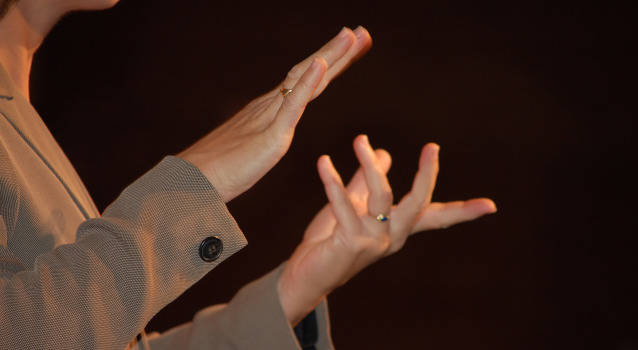Silence Speaks About Art
Have you ever stood in front of a modern, contemporary work of art and found yourself in search of the right words to describe what you are looking at? What if the words you needed to describe modern art never existed? What if you knew they were available but only in a foreign language? This, unfortunately, is the reality of people who rely on sign language to interact with the world. The difficulty is not solely in the communication but in the unavailability of words to communicate with.
As part of the 11th Italian Language Week around the World, the Italian Cultural Institute of New York hosted a presentation titled Silence Speaks About Art. It was an unveiling of the Dictionary of Contemporary Art in Italian Sign Language published by Allemandi and created by the collaboration between the Education Department of Castello di Rivoli Museum of Contemporary Art and the Turin Institute of the Deaf. This bilingual (Italian/English), wonderfully illustrated book introduces 80 new signs to the Italian Sign Language, all of which are specific to the contemporary art world. The purpose of this lexicon is to allow the speech/hearing impaired the pleasure of interaction with contemporary art by removing the previously existent barrier due to the lack of vocabulary.
First to speak at the presentation was Brunella Manzardo, a researcher and Access program coordinator from the Education Department of Castello di Rivoli Museum of Contemporary Art. She gave the audience an introduction as to how the project brings together the world of art and sign language, two fields that have not had the opportunity to interact even though both are closely linked to the visual dimension. Giving a background of the research project, she portrayed its route from a mere idea to the finished product, highlighting the many new opportunities that were created along this road for the hearing/speech impaired to interact with the contemporary art world. She emphasized what the lack of specific terminology meant to the deaf community: “there used to be a distance between deaf people and contemporary culture: not having such a linguistic heritage strongly limits the possibility for the deaf to fully appreciate modern and contemporary art and to visit museums and exhibitions without feeling excluded.”
Consequently, Enrico Dolza, a professor of Sign Language at Turin University and of Linguistics at the University of Bologna talked about the technical aspects of the creation of this lexicon and explained how and why the gestures were chosen to represent specific words. His presentation was assisted by a live demonstration of the new signs executed by Luciano Candela, a professor and researcher of the Italian Sign Language. This formed an interaction with the audience, initiating an interesting conversation between representatives from the American Sign Language Institute and the panel, which expanded on the differences between American and Italian signs.
The representatives from the American Sign Language Institute noticed that many words included in the new lexicon were actually available in ASL. Professor Dolza explained that this is not due to English being richer in vocabulary but rather because “the lexical scarcity of [Italian] sign language in a specific matter can sometimes be more similar to that of certain dialects or minority languages.” He then pointed out that: “this is not because this language has not in itself the potential resources to talk about everything, but only because no one has ever spoken about certain subjects in that particular language.”
Closing the presentation was Anna Mecugni, an art history professor at Vassar College and a lecturer at the Museum of Modern Art, who provided a final, compelling view of the history of contemporary art.







































i-Italy
Facebook
Google+
This work may not be reproduced, in whole or in part, without prior written permission.
Questo lavoro non può essere riprodotto, in tutto o in parte, senza permesso scritto.